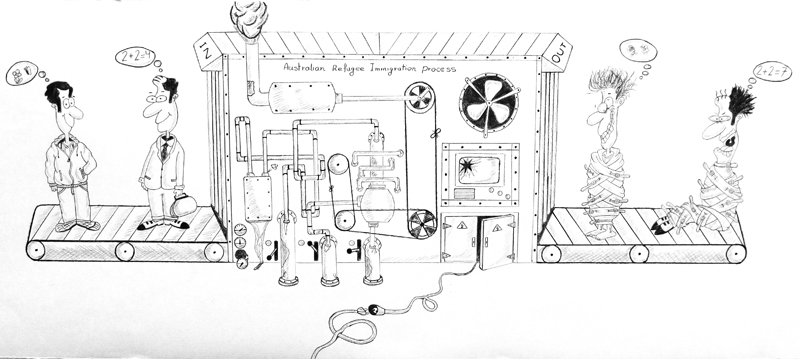
Australia’s Hysteria
The United Nations High Commissioner for Refugees (UNHCR) recently released its latest report on the number of asylum applications lodged in the 44 industrialised countries that provide statistics to the UNHCR. The 2012 report, recorded the second highest number of applications worldwide this decade with 479,300 asylum applications lodged – a global increase of 12.5%. The High Commissioner for Refugees, António Guterres, noted that asylum claims lodged in industrialised countries were only a drop in the ocean compared to the levels of displacement experienced closer to the regions of conflict:
In most cases people seeking refuge from conflict choose to remain in countries neighbouring their own in hope of being able to return home (an example is Syria, where the figure of 24,800 Syrian asylum claims in industrialized countries compares to more than 1,100,000 registered Syrian refugees currently in neighbouring countries).
Although Australia experienced a rise in asylum applications, the total number of applications registered in Australia in 2012 was a modest 15,800 compared with the 355,500 claims received in Europe and the 103,900 received in North America. As information and research from Australia’s commonwealth parliamentary library shows, since 1999–2001, when Australia last experienced a surge in boat arrivals during the Howard Government, irregular maritime arrivals (IMA’s) lodging asylum claims have consisted primarily of people from Afghanistan followed by Iraq, Iran and Sri Lanka. However, Australia has not shouldered a significant amount of asylum flows from these countries—much higher numbers of asylum seekers from these countries have gone to the UK and other destination countries. In fact, as Guterres notes, none of the industrialised countries, Australia included, shoulder a significant amount of asylum seekers compared to the developing countries neighbouring most of the world’s conflict zones. The vast majority of asylum seekers are hosted in countries such as Pakistan, so the burden of assisting the world’s asylum seekers and refugees actually falls to some of the world’s poorest countries.
So what does this tell us about Australia’s hysteria around receiving 3% of the industrialized worlds asylum applications? (3% take note, is the amount of applications lodged, not the amount of visas granted). What this tells us is that other industrialised countries, and many more poor developing countries, take many more asylum seekers than we do in Australia, and that they deal with the situation much better. Take Sweden for example, who accepts nearly 3 times the number of asylum seekers per year than we do in Australia. In Sweden asylum seekers are welcomed, are assigned their own case worker and lawyer, are allowed freedom of movement and work rights, are allowed to live with friends or family, and are provided financial support and a housing allowance, all whilst their claims are processed in a maximum of 3 months. Sweden, it seems recognizes asylum seekers for what they are; everyday humans like you and I fleeing persecution.
What can we take from news reports like Gemma’s Jones’s Daily Telegraph with front page headlines screaming “Asylum Handouts: Julia’s Boats Baby Bonus”? Firstly that they are blatantly disingenuous. Gemma’s article refers to only one woman who was offered childcare help, and who subsequently rejected the offer. Secondly, it would be inhumane to think that someone held in an Australian facility for no legal reason is denied much needed health care.
What can we discern from the fact that Australia does not indefinitely detain convicted terrorists who ASIO has found planned acts of violence in Australia, but it does detain indefinitely asylum seekers who have not committed any act but “based on a predictive judgement that they might pose a security risk” ASIO has given them an adverse assessment? In this case ASIO itself has not stated that this treatment is required, it is our Government who has made this decision.
What these examples demonstrate is that the hysteria surrounding asylum seekers in Australia is unjustified. In Australia we are not being ‘flooded’ or ‘overun’ by asylum seekers, and the fact that other countries can deal with much larger numbers when Australia is struggling, is our politicians fault, not the fault of asylums seekers. What these examples highlight is that this current hysteria is being manufactured by our media and our politicans – who in ‘othering’ and dehumanizing asylum seekers are able to poise them as a ‘threat’ to Australia’s sovereignty which they can appear to be ‘defeating’. What the last couple of months of community processing have demonstrated, is that it is possible for asylum seekers to live in the community without their neighbours being the least bit perturbed. It seems the real threats in this debate are Australian constituents who are both xenophobic and gullible enough to buy into the hype.
Top image by JH, ‘The Immigration Process’, as part of the Refugee Art Project – www.therefugeeartproject.com
Leave a reply


Connect with us
Need help from the ASRC? Call 03 9326 6066 or visit us: Mon-Tue-Thur-Fri 10am -4pm. Closed on Wednesdays.